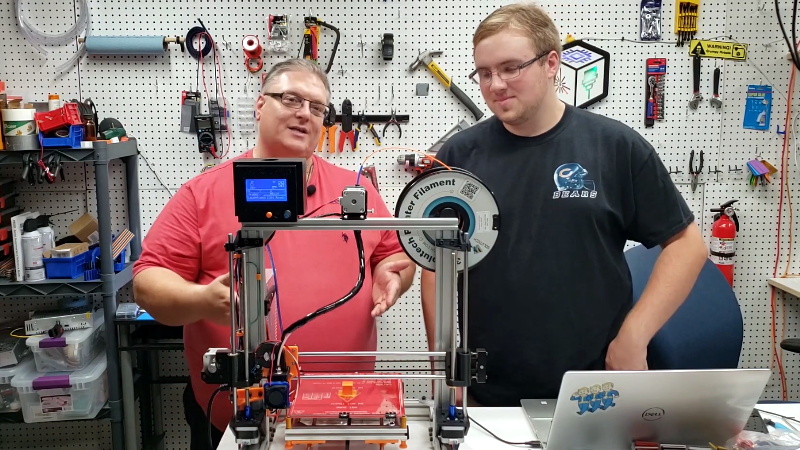Today it’s almost always cheaper to buy an imported 3D printer kit than it is to source your own parts and build one yourself. But that doesn’t stop people from doing it anyway. Whether they’re looking for something a bit more solid, or just want to do things their own way, there are still valid reasons to design and build your own machine. Luckily for us in the audience, [Rob Mech] decided to document the build of his custom “LayerFused C201” printer on his YouTube Channel.
If you’ve ever dreamed of taking the plunge and building a 3D printer exactly the way you want, but were never able to manage the time, this seven video series might be the next best thing. Each video takes you through a different step of the construction, from building the frame out of aluminum extrusion all the way to wiring up the endstop switches and the 32-bit SKR v1.3 controller. There’s even a video that introduces the viewer to the concept of a “Frankenstein” printer that uses cobbled together parts just long enough to produce its own final components.
All told, [Rob] says the Bill of Materials for the LayerFused C201 comes to at least $200, but that’s going to take shopping around for the lowest possible prices and potentially even salvaging some components from other machines and projects. Like we said, building a cheap printer is absolutely not the goal here; it’s all about building a printer you want to use.
















After assembling the Ender 3, i’m surprised we didn’t have these things 30 years ago. I could easily see a younger me hooking up a 3d printer to my commodore 64. There’s no reason the C64 couldn’t control 3 steppers and 2 heaters. Slicing would likely take 500% longer though.
You think slicing would take 500% longer? Try 5 million times longer. And certainly not enough RAM.
Forget 3D modeling and slicing. Write the gcode from scratch in a text editor.
Help!!!
My anorak zip has broken!
… Could you 3D print me a new one?
Sure, I have a basic program to generate gcode thanks to dividing the piece in simples forms and use of loops from 0 to the height of the zip
by now some beard would have figured out how to do slicing in real time by exploiting an obscure VIC-II bug
Bring your 3d printer in your next time-travel and “will” see what 80’s boys can do with a 6502 and basic. (Please take more magnetic tapes)
Text editor.. text editor.. what’s a text editor? You’d be writing a BASIC program to export the gcode using PRINT statements.
But no, that wouldn’t work; we didn’t have the microcontroller infrasctructure then – no C code on microcontrollers. And anyway, the 6502 was the microcontroller of the day, so it would have been a game cart containing the stepper motor drivers (yes, there were stepper motors then), and POKE commands in the basic program for the part you were printing.
3D printing and CNC is basically the same, just processing GCODE.
So, as an inspiration tho those who care/dare:
https://www.youtube.com/watch?v=tlLVgO7X_C0
Regarding, slicing modelling etc. there are always ways to work around that, just don’t expect it will work the same as you are used to (considering limited RAM and processing speed). The arduino boards controlling printers these days aren’t that different from a C64, the only main difference is storage (the SD-card with the GCODE file) and there were harddisks available or even the modest 1581 drive could hold a fairly large file of 800K. Now GCODE is quite inefficient because it uses text to describe numbers, so there is a lot to gain to drop GCODE and go for a true binary file.
AVRs are surprisingly powerful for an 8bit though, 1 MIP per mhz, so a bit faster than a C64, not that there weren’t fast microcontrollers around by the late 80s/90s though.
Probably around 1990 was the magic time when it all could have come together, with 3D packages such as POVray, Imagine, Real3D, Lightwave appearing on the Amiga, the ability to create and handle 3D objects on the desktop was established, though it would probably be an overnight thing to render and again to slice. Autocad 3D was pretty well developed by that time also.
We had to wait until patents expiration. 3D printing is here for very long time in industry. But after patents we were able to build 1st personal 3D printers.
I remember using Skeinforge back in the day (6 years ago or so) for slicing. You’d have to really think about hitting that slice button before doing it since it’d be a while. A complex model could take 10-30 minutes to slice, today it would take a few seconds at worst.
Patents and ip abuse does this more than you’d think. Of course there would be limitations, but we should’ve had it a lot sooner and there would be plenty of developments by now we don’t have yet because of it.
8bit sub mips doing 3D slices in < 64KB and swapping to 180KB floppy. That funny. Hope the alignment holds out on 1541 for ya.